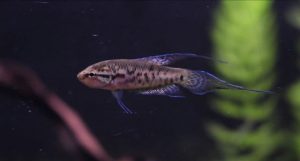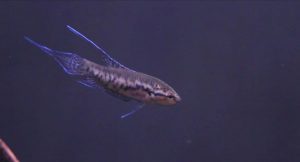
Source: https://www.unter-wasser-freiburg.de/
Mal Pulutta As the common name suggests the clear blue flowers on the fins enhance their beauty. Malpulutta kretseri Introduced to the world as a new species of fish by zoologist PEP Deraniyagala in 1937, It was scientifically named Cretaceous in honour of Mr Kretseri, a Sri Lankan lawyer who first discovered it. Commonly known as Ornate Paradise Fish and has very similar morphological characteristics to Paradise fish (Macropodus opercularis). M. kretseri belongs to the Family Macropodinae and Genus Malpulutta which is an endemic genus to Sri Lanka. And it is the only fish that belongs to this genera.
Malpulutta kretseri (Male) ©Shafran Packeer
Malpulutta kretseri(Male) ©Shafran Packeer
Males are reddish-brown in colour and there are two parallel, black coloured, dotted lines on both lateral sides. Their caudal, dorsal and pelvic fins are more elongated than the female. And also their middle ray of the caudal fin is longer than other rays. It gives a pointed shape for the caudal fin. Females are light brown in colour and have rounded fins. They are much similar to Pseudosphromenus cupanus (Spiketail paradisefish). M. kretseri is a labyrinth fish species which means they have a lung-like labyrinth organ which helps to breathe atmospheric air. Hence they come to the surface from time to time to get air from the atmosphere. During spawning, the male builds a nest of air bubbles on the underside of an aquatic plant leaf on the surface of the water using special saliva like material produced by the fish. If there are no floating leaves on the surface, the nest builds up near the surface of the water in the roots of plants hanging in the water. When building a nest, the male does not allow the female to come near it. Once the nest is built, the female lays her eggs inside. After laying eggs, the male strikes the female again and chases her away. Environmentalists say that in some cases, females even suffer fatal injuries. Even after laying eggs, the male protects the nest from enemies. About 36-48 hours after hatching, the chicks hatch. If the young come out and fall into the water without being able to swim, the male will take the young out of his mouth and put them back in the nest. The male cares for the young until they can swim. The male also provides the necessary protection for their young to hide from enemies when they are young. When threatened, they hide under leaf litter and they are able to camouflage well because of their colour.
Zoologists say Malpulutta is confined to a triangular stretch of slow-flowing, well-shaded muddy bottom between Colombo, Galle and Ratnapura districts (South Western area of Sri Lanka). In the 1970s and 1990s, the population of this fish was greatly reduced due to the rapid export of pet freshwater fish through the industry. After 1993, with the change of the Wildlife Ordinance, K. malpulutta is known as a protected species in Sri Lanka.

Source: https://www.unter-wasser-freiburg.de/
References:
Pethiyagoda, R., 1991. Freshwater fishes of Sri Lanka. Wildlife Heritage Trust of Sri Lanka, pp. 260-268.
Pethiyagoda, R., 1994. Threats to the indigenous freshwater fishes of Sri Lanka and remarks on their conservation. In Ecology and Conservation of Southeast Asian Marine and Freshwater Environments including Wetlands (pp. 189-201). Springer, Dordrecht.
Wijesekara, R.G.S. and Yakupitiyage, A., 2001. Ornamental fish industry in Sri Lanka: present status and future trends. Aquarium Sciences and Conservation, 3(4), pp.241-252.
https://www.unter-wasser-freiburg.de/Malpulutta-kretseri-Waldbachbluete-Eigene-NZ
Related articles: Bengal Swamp Eel – Ophisternon bengalense
Lesser Swamp Eel – Ophichthys desilvai






